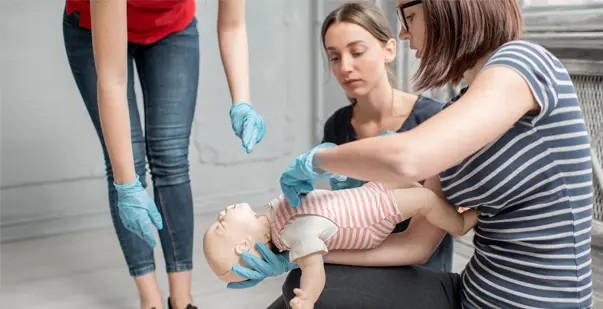A staggering 70% of parents reportedly feel ill-prepared for a medical emergency involving their child, revealing an urgent need for widespread education on this critical skill. The process may seem scary, but in reality, it’s all about understanding the fundamentals and doing the correct drills. For instance, hands-only CPR entails kneeling above the child and placing your hand on their chest in between. Caregivers of children with special needs require training programs to equip them adequately enough to deal with emergencies effectively. Let us get into details on how to provide CPR for children with special needs.
What are the essential steps in performing CPR on children with special needs?
Children require their own methodology, comprehension, and set of skills. It is important to understand the process for immediate and proper care during an emergency. These measures not only target saving lives but also prevent as much damage until professional medical attention is sought. Let’s take a look at these critical steps:
- Assess the Situation: The first step is to assess the surroundings for safety and then verify the responsiveness of the child. Talk loudly and shake the child gently without hurting it. If there is no answer, move onto the second step.
- Call Emergency Services: Upon ascertaining that the child is unresponsive, call your local emergency line immediately. It’s crucial to get professional medical help on the way as quickly as possible.
- Check for Breathing and Pulse: Check a child’s breathing and pulse within 10 seconds. If the child is not breathing or if the pulse is weak or absent, start chest compressions.
- Begin Chest Compressions: Put your hands on top of each other in the center of a child’s chest and do fast compressions. Aim for 30 compressions at a steady rate, followed by two rescue breaths.
- Perform Rescue Breathing: After 30 chest compressions, give two rescue breaths. Perform a head-tilt or chin lift, pinching the child’s nose shut. Take a normal breath and make a complete seal over the child’s mouth with yours. In case the child does not answer or breathe normally, repeat this procedure until help comes.
Read More: Three P’s and three C’s of first aid
How does first aid for children with special needs differ from regular first aid?
First aid for children with special needs should be more flexible and personalized compared to regular ones. This is because children with particular disabilities or conditions might react in a different way regarding traditional first aid measures, and they can require additional support or modifications. Identifying these distinctions is critical to adequate and secure emergency care. Here are some ways in which first aid for children with special needs can differ:
- Understanding the Child’s Condition: Children with special needs might have peculiar medical conditions, which impact how they respond to various emergencies or treatments. For example, a child with epilepsy will need special procedures during the seizures, which may not apply to children without this condition.
- Communication Differences: The inability to express discomfort and pain is typical for children with special needs, especially those suffering from communication difficulties. Thus, caregivers should pay attention to the non-verbal cues or changes in behavior that could signify suffering or injury.
- Use of Medical Devices: Some children with special needs may need medical gadgets, such as feeding tubes, among others. Handling these devices efficiently during an emergency is important to prevent further damage.
- Potential for Choking: Children with some conditions, such as cerebral palsy, may demonstrate the difficulty of swallowing and their increased risk of choking. These children could require special training in choking first aid and prevention.
- Medication Administration: In emergencies, some children with special needs may require specific medications. First aid training for kids helps you understand the right dosages, administration techniques used, and associated side effects.
Why is it crucial to modify CPR and first-aid techniques for children with special needs?
Modifying CPR and first aid techniques for children with special needs is crucial for several reasons. These are crucial to cater to the unique health conditions and physical abilities of these children. Learn why it is vital to modify CPR and childrens’ first aid techniques:
- Unique Health Conditions: Special needs children may have comorbidities that can modify their response to emergencies or treatments. For instance, a child with seizures may require specific steps during a seizure that are not typically included in generic CPR procedures.
- Physical Abilities: Based on their physical growth, some children may not be able to carry out standard chest compressions in CPR procedures. Therefore, adjustments are crucial to ensure they receive effective resuscitation.
- Communication Capacities: It is crucial to administer special first aid and CPR differently to children with special needs compared to those without because of the differences associated with communication. Caregivers must be aware of any non-verbal cues or changes in behavior that may indicate distress or injury.
- Use of Medical Devices: Some children with special needs may resort to relying on medical apparatus such as feeding tubes or ventilators. Knowing how to handle these devices correctly during an emergency is essential to avoid causing further harm.
- Building Confidence and Understanding: To increase the confidence and understanding of participants, first aid training is modified based on their needs and interests. This is particularly important for caregivers of children with special needs, as it helps them improve their life saving skills.
Read More: First aid courses in Seattle
Conclusion
Giving CPR for children with special needs requires knowing their health problems, how they walk around in their area of life, and communicating. It is about alternative steps, looking for signs of breakdowns, using clinical devices properly, and knowing what emergency medicine to use. Caregivers can learn all this through a kids first aid course, and when trained well, they will be able to help kids during emergencies.













